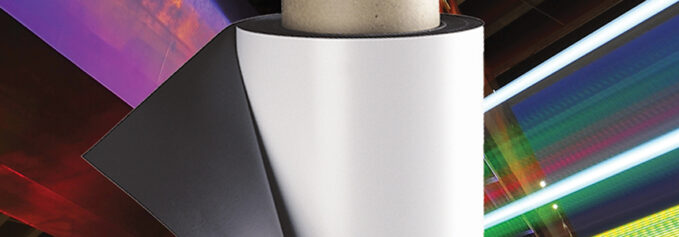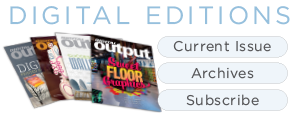
By Melissa Donovan
Combining magnetic media with pressure-sensitive vinyl, banner material, rigid substrates, and fabric—it completes the list for a print provider striving to become a one-stop shop.
Like any substrate it has its challenges, but strides continue in developing magnetic signage options that work with today’s wide format—and even narrow format—printers.
If you aren’t printing to magnetic media yet, we hope this article makes you take a second look.
Above: XCEL offers to build recycling programs when there is a need or interest in regards to its magnetic material.
Top Spot
Digitally printed magnets used in signage are seen in a number of environments and applications. According to Brian Ebenger, VP of business development, XCEL, top applications include indoor/outdoor signage, retail graphics, vehicle advertising, postcards, labels, business cards, and interior wall décor.
“Magnetics are used in business cards, postcards, and labels for the simplicity of reuse and durability. Magnetics in interior wall décor, vehicle advertising, and other signage is helpful for ease of install while also durability and a professional look,” he continues.
Large retailers enjoy using magnetic signage because of “its ease of installation and the ability to change and refresh graphics. It can be kitted and shipped to multiple locations, which allows the in-store staff to install the graphics and removes the need for a professional installer,” notes Matthew Adams, sales executive, North America, Newlife Magnetics, LLC.
Keeping It Up
Despite the variety of applications associated with magnetic signage, many print shops do not offer magnetic opportunities to their clientele.
While “print service providers (PSPs) are familiar with the car sign and business card type applications, fewer are familiar with the magnet base and magnet-receptive media system—the advantage of which is it brings customers back for more magnet receptive prints,” admits Adams.
For some PSPs not using magnetic sheets may be because they don’t own the proper printing devices. “Magnet is heavy to handle and thicker than most media, which makes this more difficult to run through some equipment,” explains Ebenger.
Adding to this, rolls are generally shorter due to the heaviness of the material. “This impacts the amount of time to load and equipment downtime. Additionally, due to thicker composition, magnetic will be more rigid,” continues Ebenger when sharing more reasons why PSPs are averse to this material.
In response, vendors have started to craft materials optimized for specific printers. For example, Magnum Magnetics Corporation took its popular DigiMaxx product and tailored it for Canon U.S.A., Inc. Colorado series printers equipped with a magnetic media kit. DigiMaxx Colorado wide format magnetic sheets are available in rolls of 40- or 48-inch widths and 40-foot lengths. The materials are designed to leverage Canon’s UVgel inks to ensure graphics deliver color accuracy and durability. The best part—although the material is optimized for Canon Colorado series printers—DigiMaxx Colorado is also compatible with eco-solvent, solvent, latex, and UV inkjet printers.
“Many print providers think it is difficult to print directly to magnet, but with today’s devices it is super easy, whether you are printing small format or wide format Newlife Magnetics has a variety of media options. This allows print shops to tap into a great new revenue stream,” suggests Adams.
Ebenger agrees that those interested in magnetic signage shouldn’t be deterred. “This can be an additional revenue stream for the printer and can often be sold to current clientele that are likely to buy elsewhere or may not know magnetic media is an option. Additionally, it can likely be printed/cut on the existing equipment so there is no need for additional costs to enter this area.”
Trending Topics
Within the last few years topics surrounding digitally printable magnetic signage included thinner gauge materials and sustainability/recyclability.
Still top of mind in the manufacturing arena, many vendors offer thinner gauge materials, which addresses the aforementioned concern of thicker media running through a printer. “Thinner gauge magnets help give options to printers that have equipment that cannot fit the traditional 0.030,” explains Ebenger.
Sustainable materials are relevant and many products are easily recycled. XCEL offers recyclable magnetic media. The company also works with its customers and offers to build recycling programs when there is a need or interest.
Newlife Magnetics is an industry leader in sustainability. Most of its media is PVC free and the company’s magnet-receptive media contains 32.4 percent post-consumer recycled content. Environmental certifications are available for the products, like its magnet-receptive print media Platinum ST540. The 8-mil matte white PET print surface is coated for a total thickness of 12 mil. The high-density ferrous coating contains a lot of metal but is super smooth to prevent marring when it is rolled up on itself in a shipping tube. Platinum ST540 is recyclable for waste to energy.
Adams Magnetic Products also offers sustainable benefits. According to a recent blog post, the company’s flexible magnet sheet is made from 75 percent recyclable materials, which are 100 percent pre-consumer product. Some versions of printable—coated, not laminated—magnet sheet are actually 100 percent recyclable and can be added back into the manufacturing process to make more magnet sheet. This includes its GreenMAG printable magnet sheet, which is coated instead of laminated.
Beyond environmental concerns and thinner materials, Adams says another trending topic involves smaller format media. Newlife Magnetics, for example, expanded beyond wide format, into the small format digital market with its PressMag line of pre-magnetized magnet sheets that allow HP Indigo, dry toner, and UV offset customers to print directly to magnet without having to magnetize post-print. The PressMag line is stocked in most standard sheet sizes. “This makes printing magnet on those presses much more efficient,” explains Adams.
Identifying the Best
Magnetic-based media is not a one-size-fits-all approach. It’s best to consider the current printing presses in house, as well as ink sets, before determining the type of substrates to offer to clientele. However, once this is decided upon, the benefits of the service and educating customers on the advantages comes easily. Some of the top trends to watch for include thinner gauge materials and sustainability/recyclability.
Feb2025, Digital Output


